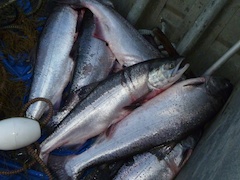
The Kuskokwim River Salmon Management Working Group is supporting two proposals that would implement a new permit system for king salmon fishing, if adopted by the State Board of Fish. The group rejected moving to a Tier 2 status.
The working group held a meeting last Tuesday to weigh in on the stack of proposals for the Kuskokwim salmon fishery.
There were representatives from all corners of the Kuskokwim salmon fishery at the meeting, including elders, subsistence fisherman, commercial fisherman, sport fisherman and members of the Alaska Department of Fish and Game.
The working group passed Proposal 97 with a 6-1 vote. The proposal submitted by the Stony-Holitna Advisory Committee asks the state to manage the Kuskokwim king salmon fishery through household subsistence fishing permits.
The Stony-Holitna Advisory Committee says Proposal 97 would provide equal opportunity to harvest up and down the river. That advisory committee, based in the upper portion of the Kuskokwim, says they have not been provided a reasonable opportunity to harvest king salmon for many years and fisherman in the lower Kuskokwim are afforded a disproportionate share of the harvest.
Working group member Mark Leary explains why the idea of an equitable harvests through permits is an attractive idea to many upriver.
“It’s a way of people getting an equal amount of fish instead of watching what we watch on Facebook- where somebody in the lower river is getting a hundred fish and somebody upriver is getting ten,” Leary said.
Some members had concerns about how the proposal could be implemented and if it would stay in place indefinitely.
Doug Molyneaux, an independent fisheries biologist, was also in attendance.
“What makes me a little concerned about this is, as it is written, it requires a permit every year, not just in years when there’s a conservation concern,” Molyneaux said.
Proposal 97 would also require permit holders to report their harvests, possibly giving wildlife managers a better tool to keep track of the fishery.
Though it looks good in theory, Molyneaux said post-season subsistence surveys seem to work better than harvest reports for tracking subsistence caught fish.
Other working-group members compared Proposal 97 to Proposal 222, citing the similarity in the household permit portion of both proposals.
The Kuskokwim River Salmon Management Working Group also voted to support proposal 222 by a vote of 6-1. Created by the newly formed Kuskokwim Subsistence Salmon Panel, the proposal asks the state to establish two types of permits in times of low abundance– one for communities and another for households.
The community permits under proposal 222 would be based on traditional usage of the salmon, like drying and smoking, and require the use of all or most of the fish.
Meanwhile the household permits under proposal 222 would be more flexible and would not be tied to how the fish is processed.
Before supporting the proposal, the advisory committee decided that household permits tied to traditional use would be a better fit for the area.
Barb Carlson from Sleetmute gave her perspective.
“Instead of having two types of permits, as put in 222, based on community household, have two types of permits based on patterns of use that are both household permits,” Carlson said. “But one would be based on the smokehouse and the utilization of heads and other parts of the fish, as compared to the utilization pattern of freezing and canning and nonsmoking.”
The Kuskokwim River Salmon Management Working Group’s support of those proposals is contrary to the recommendations by the Lower Kuskokwim Advisory Committee, which voted unanimously against both proposals last month.
However, the two groups are in agreement in their opposition of proposal 95, which would turn the Kuskokwim Chinook fishery into a Tier 2 fishery after the recent years of low king runs. The working group unanimously rejected that proposal.
It cites a current state law that says if the harvestable population is too low to allow for a regular fishing season for all subsistence users, the state has to implement a system to decide who among subsistence fishermen should be allowed to harvest that particular species. This proposal would only come into effect in times of low abundance or conservation.
Bethel resident Grant Fairbanks introduced the proposal last year during a Board of Fish meeting. He introduced it again, saying it would give upriver and lower river fisherman an equal chance to fish and even give fishing opportunities to some subsistence users in times of conservation.
Ray Collins from McGrath worried a Tier 2 permit system would do more harm than good.
“People up here didn’t even go out salmon fishing this year, because the hours were so short that it wasn’t worth while,” Collins said. “So, there’s been a decline in subsistence fishing up here, because of the regulations in place which would mean they would get lower points than someone that has been fishing all the time.”
Tier 2 permits distinguish between individual subsistence users based on three criteria: customary dependence, proximity to the resource, and availability of other resources. Collins feels that under the given criteria many upriver fisherman would remain at a disadvantage under a Tier 2 permit.
These and other proposals along with recommendations will be considered at the Board of Fish Arctic Yukon Kuskokwim Finfish meeting in Fairbanks, January 12-16, where they could be adopted or denied.
Charles Enoch is a reporter at KYUK in Bethel.




